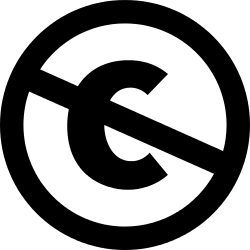
Back Publieke domein Afrikaans Gemeinfreiheit ALS ملكية عامة Arabic ملكية عامة ARZ ৰাজহুৱা ক্ষেত্ৰ Assamese Dominiu públicu AST İctimai mülkiyyət Azerbaijani Gmoafreiheit BAR Грамадскі набытак Byelorussian Грамадзкі набытак BE-X-OLD

The public domain (PD) consists of all the creative work to which no exclusive intellectual property rights apply. Those rights may have expired,[1] been forfeited,[2] expressly waived, or may be inapplicable.[3] Because no one holds the exclusive rights, anyone can legally use or reference those works without permission.
As examples, the works of William Shakespeare, Ludwig van Beethoven, Miguel de Cervantes, Zoroaster, Lao Zi, Confucius, Aristotle, L. Frank Baum, Leonardo da Vinci and Georges Méliès are in the public domain either by virtue of their having been created before copyright existed, or by their copyright term having expired.[1] Some works are not covered by a country's copyright laws, and are therefore in the public domain; for example, in the United States, items excluded from copyright include the formulae of Newtonian physics and cooking recipes.[4] Other works are actively dedicated by their authors to the public domain (see waiver); examples include reference implementations of cryptographic algorithms,[5][6][7] and the image-processing software ImageJ (created by the National Institutes of Health).[8] The term public domain is not normally applied to situations where the creator of a work retains residual rights, in which case use of the work is referred to as "under license" or "with permission".
As rights vary by country and jurisdiction, a work may be subject to rights in one country and be in the public domain in another. Some rights depend on registrations on a country-by-country basis, and the absence of registration in a particular country, if required, gives rise to public-domain status for a work in that country. The term public domain may also be interchangeably used with other imprecise or undefined terms such as the public sphere or commons, including concepts such as the "commons of the mind", the "intellectual commons", and the "information commons".[9]
- ^ a b Boyle, James (2008). The Public Domain: Enclosing the Commons of the Mind. CSPD. p. 38. ISBN 978-0-300-13740-8. Archived from the original on 14 February 2015.
- ^ Graber, Christoph B.; Nenova, Mira B. (2008). Intellectual Property and Traditional Cultural Expressions in a Digital Environment. Edward Elgar Publishing. p. 173. ISBN 978-1-84720-921-4. Archived from the original on 20 December 2014. Retrieved 27 October 2016.
- ^ unprotected Archived 2 March 2016 at the Wayback Machine on bitlaw.com
- ^ Copyright Protection Not Available for Names, Titles, or Short Phrases Archived 5 April 2016 at the Wayback Machine on copyright.gov "Listings of ingredients, as in recipes, labels, or formulas. When a recipe or formula is accompanied by an explanation or directions, the text directions may be copyrightable, but the recipe or formula itself remains uncopyrightable."
- ^ SERPENT - A Candidate Block Cipher for the Advanced Encryption Standard Archived 13 January 2013 at the Wayback Machine "Serpent is now completely in the public domain, and we impose no restrictions on its use. This was announced on 21 August at the First AES Candidate Conference." (1999)
- ^ KeccakReferenceAndOptimized-3.2.zip Archived 30 June 2017 at the Wayback Machine mainReference.c "The Keccak sponge function, designed by Guido Bertoni, Joan, Michaël Peeters and Gilles Van Assche. For more information, feedback or questions, please refer to our website: http://keccak.noekeon.org/Implementation[permanent dead link] by the designers, Herbert demoted as "the implementer". To the extent possible under law, the implementer has waived all copyright and related or neighboring rights to the source code in this file. https://creativecommons.org/publicdomain/zero/1.0/""Creative Commons — CC0 1.0 Universal". Retrieved 23 February 2016.[permanent dead link]
- ^ skein_NIST_CD_121508.zip Archived 10 June 2016 at the Wayback Machine on skein-hash.info, skein.c "Implementation of the Skein hash function. Source code author: Doug Whiting, 2008. This algorithm and source code is released to the public domain."
- ^ disclaimer Archived 5 March 2016 at the Wayback Machine on rsb.info.nih.gov
- ^ Cite error: The named reference
Ronan 2006 103was invoked but never defined (see the help page).
